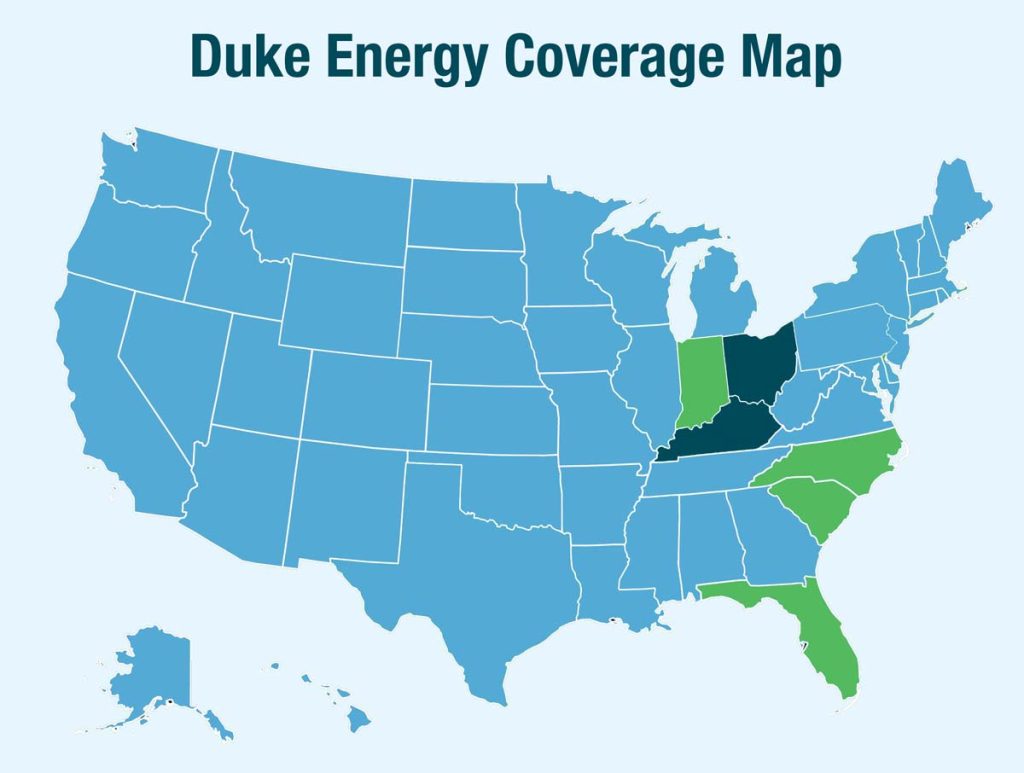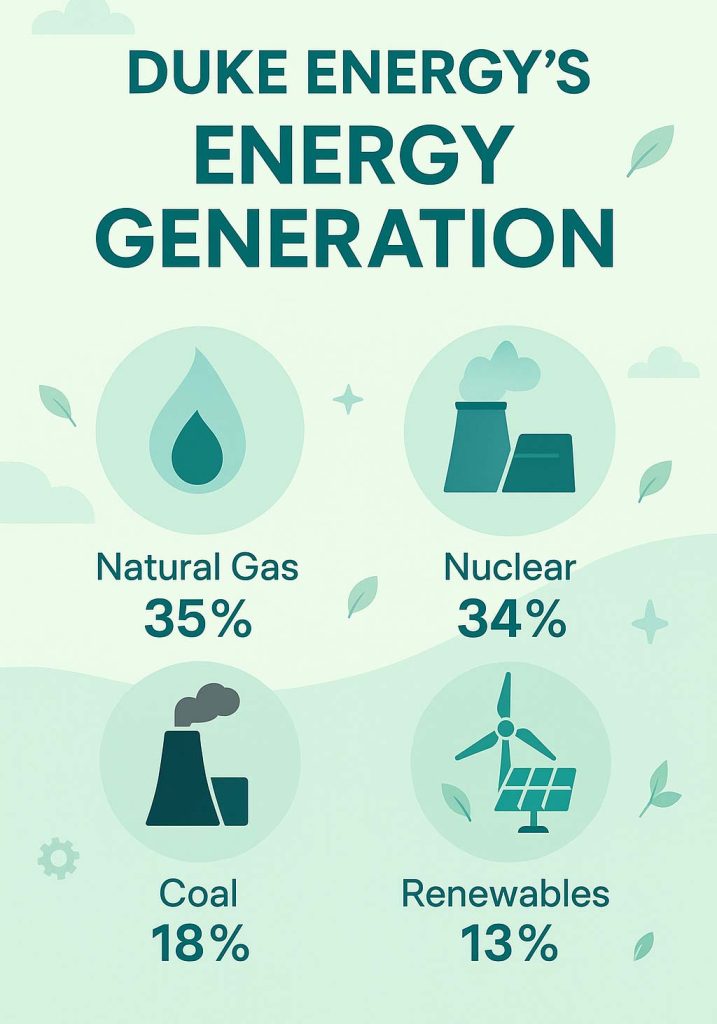- In most states, Duke is the default electricity provider, so you typically don’t choose your supplier unless you’re in a deregulated market like Ohio or Kentucky.
- Duke supplies both electricity and natural gas in select areas, mainly around Cincinnati (OH) and northern Kentucky.
- Their plans are standard, regulated rates with no contracts, no cancellation fees, and consistent service.
- Duke offers optional renewable energy add-ons and rebates on smart thermostats, EV chargers, and efficient HVAC systems.
About Duke Energy
Duke Energy is one of the largest U.S. energy holding companies. Its electric utilities serve about 8.6 million customers across the Carolinas, Florida, Indiana, Ohio, and Kentucky, and its natural-gas utilities serve about 1.7 million customers in North Carolina, South Carolina, Tennessee, Ohio, and Kentucky. Duke says it owns about 55,100 MW of generation capacity and is investing heavily in grid modernization and the clean-energy transition. With roots dating back over a century, Duke has become a household name in many regions, providing a mix of electricity generation from nuclear, coal, natural gas, hydroelectric, solar, and wind sources. The company has a strong focus on sustainability, aiming to reach net-zero carbon emissions by 2050, and it invests heavily in modernizing the grid to improve reliability and integrate more renewable energy.
- Calculate Your Moving Costs
- Compare Moving Companies
- Get Multiple Quotes
- Move with Confidence
Duke Energy Coverage Areas

Duke Energy’s regulated utility operations cover large parts of North Carolina, South Carolina, Florida, Indiana, Ohio, and Kentucky. It’s important to know that in some states like Ohio, you can choose a retail electric providers (REPs) in a competitive market, but Duke operates primarily in regulated markets, meaning you purchase electricity directly from Duke rather than choosing from competing suppliers.
- North Carolina and South Carolina (electric): Duke Energy Carolinas and Duke Energy Progress serve most of these two states, making them the dominant electric utility provider. They supply power to both large metro areas like Charlotte, Raleigh, Durham, and Greenville as well as rural communities.
- Florida (electric): Through Duke Energy Florida, the company provides electric service across central and northern Florida, including areas like St. Petersburg, Clearwater, and parts of Orlando and the Gulf Coast.
- Indiana (electric): Duke Energy Indiana supplies electricity to central and southern parts of the state, including cities like Bloomington, Terre Haute, and Plainfield.
- Ohio (electric and natural gas): Duke Energy Ohio serves both electricity and natural gas customers, mostly in the Cincinnati metro area and surrounding southwest Ohio counties. Importantly, electricity and natural gas supply are both deregulated here, giving customers the option to choose a REP or gas supplier for the supply portion.
- Kentucky (electric and natural gas): Duke Energy Kentucky covers electric and natural gas customers mainly in northern Kentucky, across counties like Boone, Kenton, and Campbell, right across the river from Cincinnati. Cities include Covington, Florence, and Newport.
Duke announced an agreement in July 2025 to sell its Tennessee gas distribution business to Spire (expected closing in 2026), part of a broader refocus on electric grid and energy-transition investments.
Types of Energy Duke Supplies

Duke Energy supplies both electricity and natural gas to customers, but availability depends on the region.
- In North Carolina, South Carolina, Florida, and Indiana, Duke primarily provides electricity services.
- In parts of Ohio and Kentucky, Duke Energy supplies both electricity and natural gas, they manage gas distribution and also deliver supply, though customers can choose alternative natural gas suppliers in deregulated markets if they want to shop for rates.
For electricity, Duke generates power using a diverse mix: natural gas, nuclear, coal, hydroelectric, solar, and wind. For natural gas, they focus on safe, reliable delivery through local pipelines to homes and businesses, offering flexible billing and energy-saving options for gas users.
Their growing renewable portfolio means you may have the option to enroll in programs that support clean energy, even if your specific energy plan is regulated.
Renewable energy & conservation efforts
Duke Energy has committed to a bold transformation of its energy-portfolio: it’s working to achieve net-zero carbon emissions by 2050. To get there, the company is doubling down on renewables, expanding solar farms, investing in battery storage, and modernizing its grid infrastructure to better handle intermittent resources like wind and solar. For example, Duke says they will add gigawatts of new capacity in the next few years, with sizable solar and storage projects in both regulated and unregulated markets. At the same time, they’re phasing out older coal-fired generators, upgrading hydroelectric assets, and exploring advanced nuclear options, all part of their roadmap to a cleaner, reliable future.
But it’s not just about big power-plants. Duke’s conservation and customer-efficiency programs play a big role too. They offer programs like the “Neighborhood Energy Saver” initiative, which provides free home energy assessments in eligible neighborhoods to find and fix inefficient systems, drafty homes, and old HVAC equipment. They also offer optional renewable-energy add-ons for customers who want to support green power, such as clean-energy blocks or renewable-energy certificates. By helping homeowners reduce their consumption and giving access to greener supply options, Duke’s working on two fronts: cutting carbon and saving customers money on bills.
On the land and ecosystem-front, Duke is very active when it comes to natural-resource stewardship. Their Forest Management Plan covers timber production, habitat restoration, watershed protection, and recreational access on lands they manage. They also run grants through the Duke Energy Foundation for environmental-resilience projects, clean-water programs, and biodiversity protection. So if you’re someone who cares about more than just kilowatt-hours, and also cares about how energy companies impact the environment around us, Duke is making visible moves.
Choosing a Retail Electric Provider (REP)
Choosing a retail electric provider (REP) over Duke Energy can offer more flexibility, customization, and sometimes even cost savings, depending on your household’s needs. While Duke Energy provides standard regulated rates and reliable service, REPs in deregulated markets (like Ohio or Kentucky) give you the power to shop around for plans that fit your lifestyle. You might find fixed-rate plans that protect you from seasonal price swings, variable-rate plans if you prefer market-driven rates, or even time-of-use or free nights/weekends plans if your energy use is concentrated at certain hours. Many REPs also offer 100% renewable energy plans, letting you align your electricity use with your sustainability goals in ways Duke’s standard mix may not.
Another advantage of choosing a REP is access to special perks and programs. Some providers bundle in smart home devices, energy-saving tools, or loyalty rewards that Duke’s basic supply service doesn’t include. If you’re someone who likes to comparison shop, lock in a long-term price, or tap into promotional offers, going with a REP can put more control and potential savings in your hands, as long as you read the fine print and understand the contract terms.
If you’re in a deregulated market like parts of Ohio or Kentucky served by Duke, you can shop for a REP. Here’s some things to consider:
- Price per kWh: Compare fixed-rate, variable, or time-of-use plans to see what fits your household’s needs.
- Renewable energy options: Some REPs offer 100% green energy plans if you want to lower your carbon footprint.
- Contract terms: Watch for early termination fees, contract lengths, and any fine print.
- Reputation: Check online reviews, customer service ratings, and reliability.
- Special perks: Some REPs offer smart thermostat deals, free weekends, or app-based usage tracking.
Compare Top Retail Electric Providers (REPs)
Constellation Energy: Offers a variety of fixed and variable-rate electricity supply plans and green‐energy add-ons, making it a strong choice if you value flexibility and renewable options.
Direct Energy: Known for its time‐of‐use and free-weekend style plans, along with fixed-rate contracts, which can appeal if your usage peaks during off-hours.
Energy Harbor: A strong regional player in Ohio that emphasizes competitive pricing and green energy options, suitable for those who want simpler, shorter-term plans.
IGS Energy: Based in Ohio and active in Kentucky and other states, IGS stands out for renewable “100% green” offers and diversified plan features.
Clearview Energy: A newer entrant but gaining attention for shorter contracts, transparent fee structures, and green-focused plans in the Ohio market.
How to Search for and Report Duke Energy Outages
- Check outages / status: Use Duke’s online Outage Map & Alerts to view current outages, estimated restoration times, and crew status, or to enroll for alerts.
- Report an outage: You can report online, via the mobile app, call your state’s Duke Energy outage line, or text “OUT” to 57801 if enrolled in alerts. (You can text RESUME to 57801 to reactivate alerts.)
About the Duke Energy App
The Duke Energy app is a handy tool for managing your account on the go. With it, you can:
- Pay your bill
- Track and report outages
- Get real-time usage insights
- Set up alerts and notifications
- Access efficiency tips and energy-saving programs
Available on iOS and Android, it’s a smart download for any Duke customer looking to stay informed and in control.
Duke Energy Rebates and Incentives
Duke Energy offers a range of rebates and incentives to help you save energy and money, such as:
- Smart $aver® home rebates for HVAC upgrades, heat pumps, insulation/duct sealing, and more.
- Smart thermostat enrollments (e.g., EnergyWise Home) with bill credits for allowing brief demand-response events.
- Online marketplace instant discounts on eligible smart thermostats and efficiency products.
These programs vary by state, so it’s a good idea to check the Duke Energy website or your local service area page to see what’s available to you.
Other Duke Energy Programs
If you’re environmentally minded, you might be interested in Duke’s Green Source Advantage program (available for some commercial customers) or the residential Renewable Advantage add-on, where you can support renewable energy projects. Plus, Duke is piloting battery storage projects and microgrid systems, showing a commitment to a more resilient and sustainable energy future.
Even if you can’t choose a REP in your area, you can still make choices about how you use and support energy through Duke’s available programs, efficiency efforts, and renewable initiatives.
Whether you’re sticking with Duke Energy or exploring your REP options, it’s worth taking a few minutes to compare prices, review programs, and understand what services are available to you. Duke’s size, history, and commitment to modernization make it a solid player, but if you’re in a competitive market, don’t hesitate to shop around to find the plan that best fits your needs.
FAQs About Duke Energy
Where Can I Pay My Duke Energy Bill?
What Are Duke Energy’s Off-Peak Hours?
How Can I Check for a Power Outage?
How Do I Report an Outage?
Pro tip: Sign up for outage alerts to get text/email updates!
Does Duke Energy Offer Renewable Energy Options?
What Payment Assistance Programs Are Available?
How Do I Start or Transfer Service?
About the Author
David has been an integral part of some of the biggest utility sites on the internet, including InMyArea.com, HighSpeedInternet.com, BroadbandNow.com, and U.S. News. He brings over 15 years of experience writing about, compiling and analyzing utility data.


